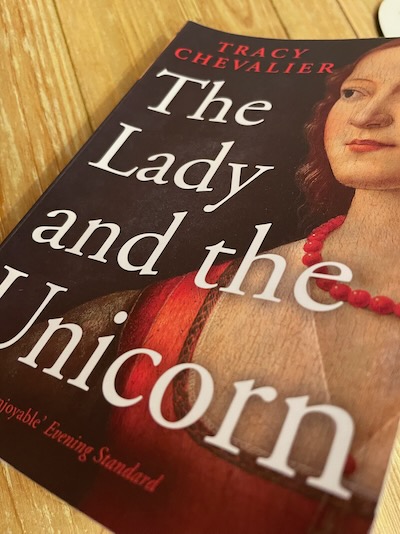Unsure about your French table manners? Click Here to download > > How to avoid these 10 food etiquette mistakes !
- Home ›
- Destinations ›
- Paris ›
- The Cluny Museum
11 Masterpieces of the Cluny Museum (including Lady and the Unicorn)
Published 15 April 2024 by Leyla Alyanak — Parisian by birth, Lyonnaise by adoption, historian by passion
The Cluny Museum on the Left Bank in the heart of Paris is often ignored in favor of the Louvre or the Orsay or other world-class attractions. But if you love the unusual and are attracted by the Middle Ages, the Cluny will be a discovery you’ll long remember. Here are some of its highlights.
Like thousands of other visitors to Paris (I live in southeastern France), I somehow bypassed the Cluny Museum for years and only decided to finally visit after reading about the famous Lady and the Unicorn tapestries.
I did it wrong the first time – I rushed through to the tapestries, which are located near the end of the visit, and neglected what is bound to be the most astounding collection of art from the medieval era in France.
A few weeks later, I was back in Paris, and my hotel happened to be located next door to the Musée de Cluny. It was a sign, and so I rushed back. This time, having seen the tapestries once, I took a more leisurely approach – and stumbled upon many of the treasures I had missed.
So don’t make the mistake I did, and take your time visiting the museum as it unfurls. I’ve tried to make it easier by highlighting 11 masterpieces I think you should look for (yes, it's a very subjective list!) on your first visit.
11 Treasures of the Cluny Museum
- 1. The Frigidarium, or Roman baths
- 2. Gallery of the Kings of Judah
- 3. Funeral slabs and decor
- 4. The treasure of Guarrazar
- 5. Stained glass windows from the Sainte-Chapelle
- 6. Altarpieces
- 7. Bookbinding plates
- 8. Directory of goldsmiths
- 9. The chapel
- 10. The chess players
- 11. Lady and the Unicorn tapestries
NOTE: Pages on this site may contain affiliate links, which support this site. See full Privacy Policy here.
It’s officially called the National Museum of the Middle Ages, but everyone knows it as “the Cluny”, and while it is most definitely a medieval museum, it is built on top of the ruins of Gallo-Roman baths, symbolically bridging the gap between the two eras.
You can see the baths from the outside, but temporary exhibitions often take place in the indoor area, shielding parts of it from view.
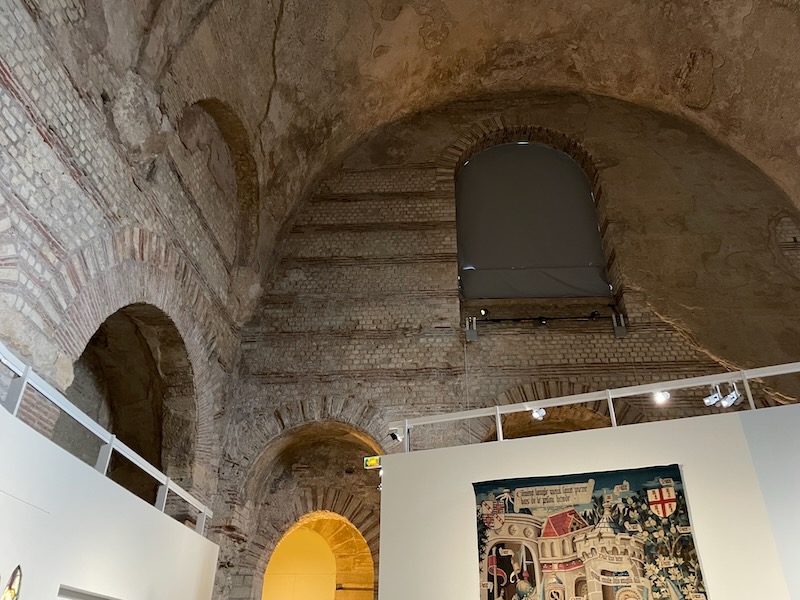 Despite the temporary exhibitions (these are always worth seeing, by the way) you can still easily get a sense of the baths' enormous dimensions ©OffbeatFrance/Leyla Alyanak
Despite the temporary exhibitions (these are always worth seeing, by the way) you can still easily get a sense of the baths' enormous dimensions ©OffbeatFrance/Leyla AlyanakLocated in the 5th arrondissement on the Left Bank’s Latin Quarter, this incredibly rich museum is within easy walking distance of Notre-Dame, just a few blocks from the Seine River.
11 Treasures of the Cluny Museum
Many of you may be in a hurry to read about the Lady and the Unicorn tapestries, and your (understandable) anxiousness may rob you of a visit to the rest of the collection. As a result, I placed them near the end of this story but – if you really can’t wait – go ahead and click through to the tapestries now. Just don’t forget to come back!
1. The Frigidarium, or Roman baths
As I mentioned, the Cluny is built upon ancient Gallo-Roman baths, of which only the frigidarium (or cold room) remains, along with its incredibly high (14m/46ft) vaulted ceiling. It dates back to the 1st or 2nd century CE and seems to me similar in overall appearance to the Constantine Baths in the southern city of Arles.
These were once part of the thermal baths of Lutetia (the Roman name for Paris), among the largest baths in the city.
If I list the Roman ruins first, it’s because the baths are located right at the museum’s entrance. And if they are partly hidden by an exhibit, don't worry, you'll find more Roman ruins, mostly walls, scattered throughout the museum's lower floors.
But now, time for the Middle Ages, which is after all what the Cluny is all about.
2. Gallery of the Kings of Judah
When you stumble into this gallery, your first reaction might be surprise.
On one side, a series of headless statues. On the other, a series of heads – without statues.
The statues (with heads) once stood along the western façade of Notre-Dame Cathedral, but were removed during the French Revolution. They showed crowned heads and as we know, the revolution was anti-monarchical, so the statues were torn down and beheaded, mistakenly thought to represent kings of France.
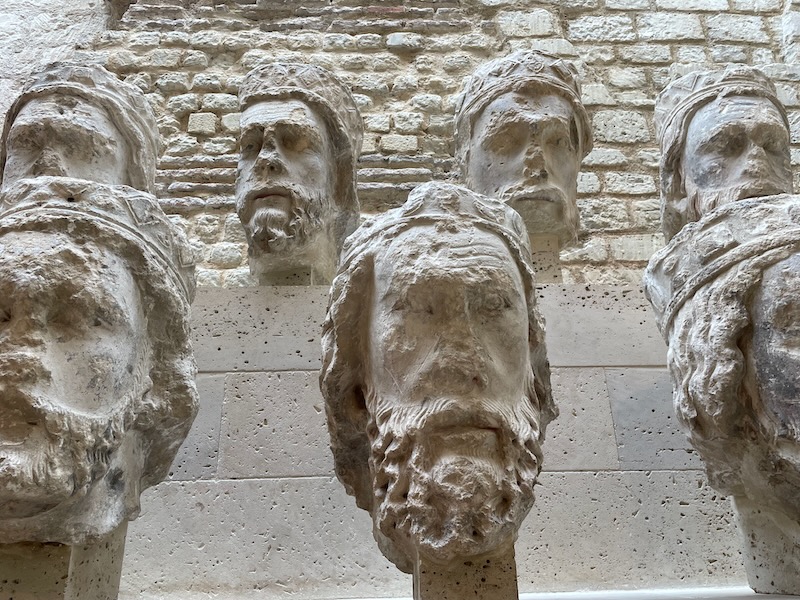
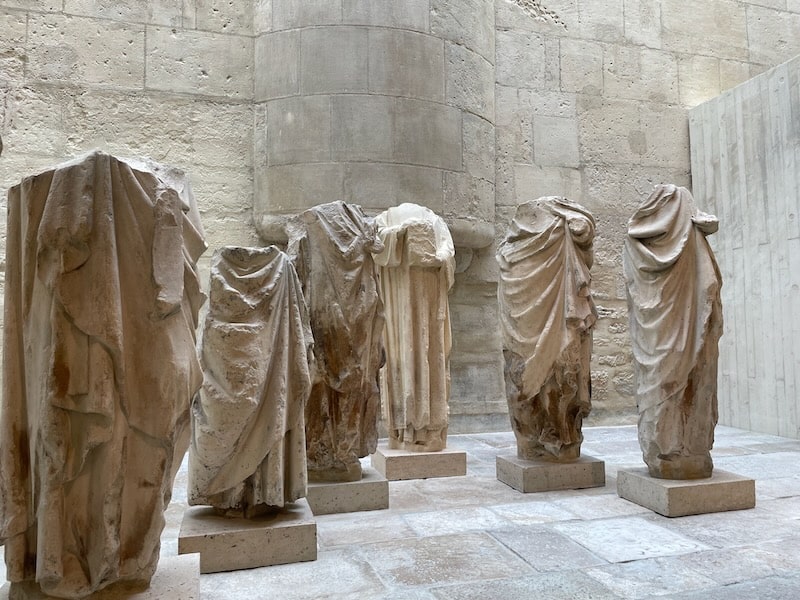 These 13th-century statues once stood along the western façade of Notre-Dame in Paris before being ripped out during the French Revolution. ©OffbeatFrance/Leyla Alyanak
These 13th-century statues once stood along the western façade of Notre-Dame in Paris before being ripped out during the French Revolution. ©OffbeatFrance/Leyla AlyanakThey weren’t French kings at all, but the Kings of Judah, ancestors of the Virgin Mary.
Two centuries after the revolution, in 1977, several statues and fragments resurfaced, the medieval sculptures unearthed during excavations in the 9th arrondissement.
Only 21 of the original 28 statues were found and placed in the museum, but this remains one of the major French archeological finds of the 20th century.
3. Funeral slabs and decor
Funeral monuments have been used for as long as societies have existed, and several intriguing examples are in the Cluny.
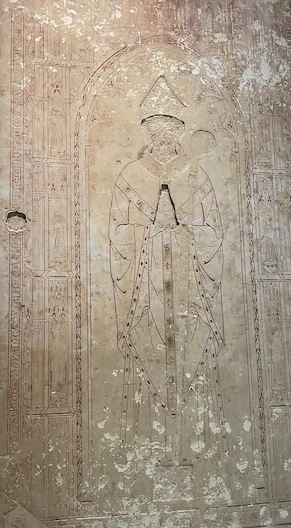
There’s a set of funeral stones mounted on the wall on your left as you head into the main part of the museum (see above), but the one that intrigued me the most was this small sculpture of two dogs.
Most men's tombs are guarded by the slightly more majestic lion, known for its bravery, but when it comes to women, dogs are often used as a symbol of fidelity.
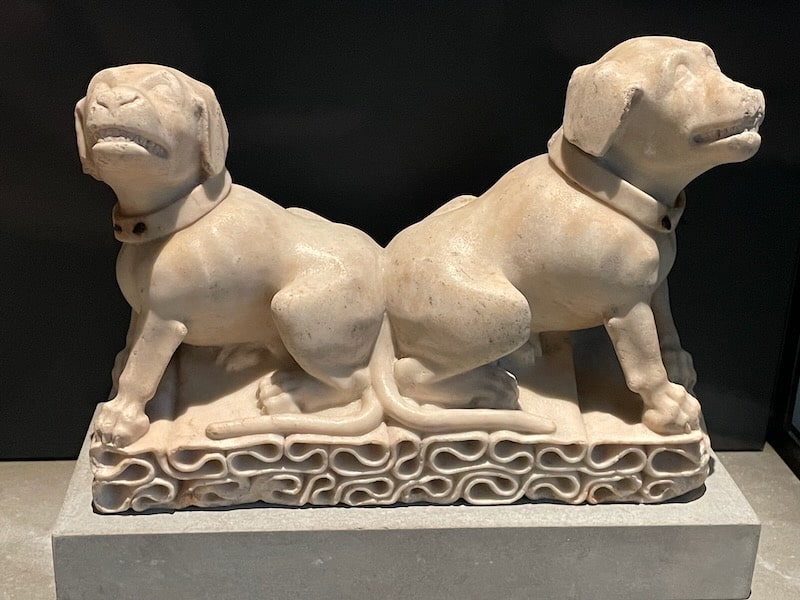
4. The treasure of Guarrazar
Of course there’s a treasure at the Cluny.
The Treasure of Guarrazar came from Spain (then Hispania) during the 7th century. It’s incredibly rich, with crowns and gold crosses and precious stones, all given in tribute to the Roman Catholic Church by Visigoth kings.
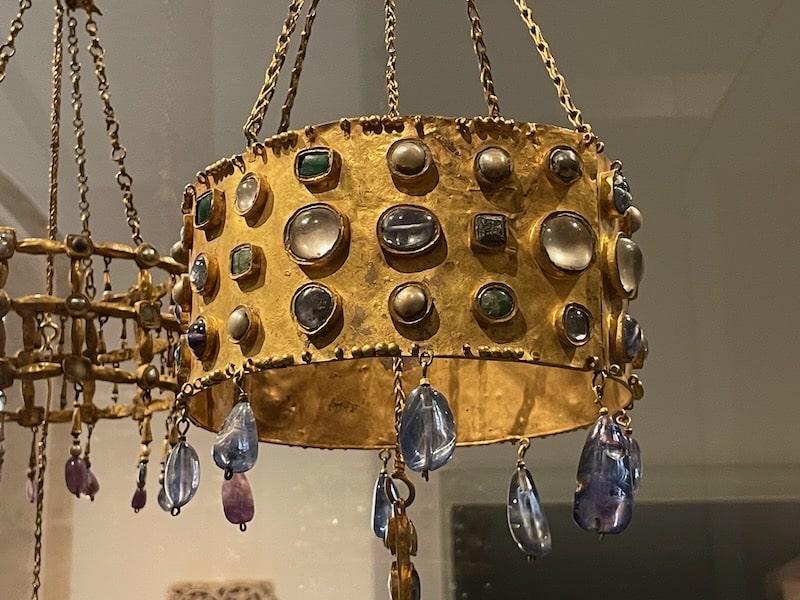 These crowns weren’t designed to be worn, just exposed on altars for all to see ©OffbeatFrance/Leyla Alyanak
These crowns weren’t designed to be worn, just exposed on altars for all to see ©OffbeatFrance/Leyla Alyanak5. Stained glass windows from the Sainte-Chapelle
There’s a wonderful exhibition of stained glass windows which once belonged to the Sainte-Chapelle, built by Saint Louis to hold the sacred relics. The pieces of stained glass are scattered throughout the room, created during the 13th century with new glass techniques that were denser and more colorful.
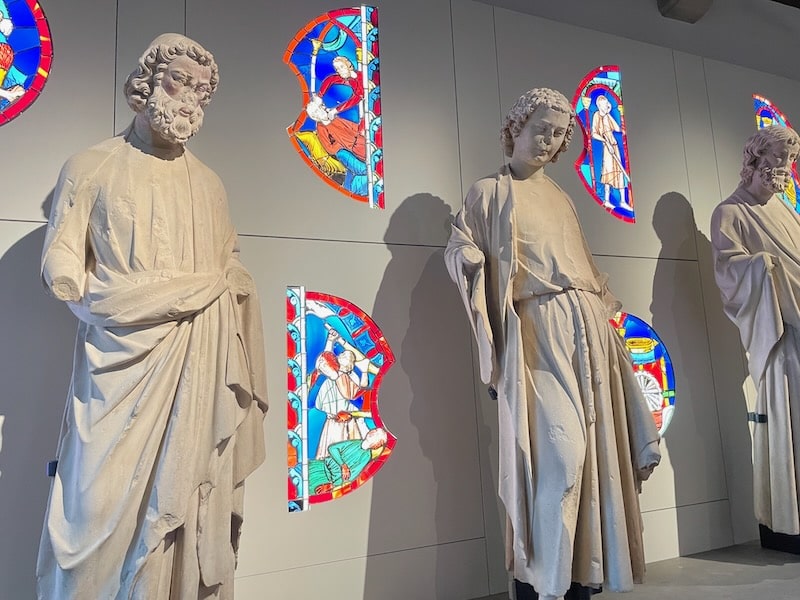 The statues were all sculpted by different artists, which accounts for their diversity in styles ©OffbeatFrance/Leyla Alyanak
The statues were all sculpted by different artists, which accounts for their diversity in styles ©OffbeatFrance/Leyla Alyanak6. Altarpieces
Religious artistry being supreme in the medieval era, it shouldn’t surprise us that much of the era’s artistic talent would be put to use to adorn religious items and structures.
The Cluny has several exquisite examples of religious altars, both fashioned in metal or sculpted in wood, using a sort of “microsculpture” technique that reveals the unbelievable craftsmanship involved here.
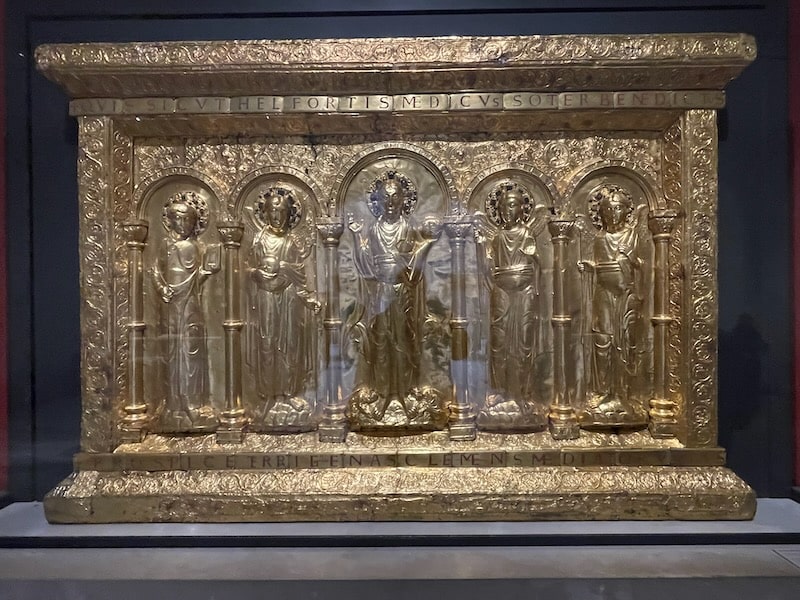 Basel Cathedral altar dates from the early 11th century in gold, symbolizing both light and wealth, donated to the church by the German emperor at the time, he and his wife are shown prostrated at the foot of Christ, showing their personal devotion ©OffbeatFrance/Leyla Alyanak
Basel Cathedral altar dates from the early 11th century in gold, symbolizing both light and wealth, donated to the church by the German emperor at the time, he and his wife are shown prostrated at the foot of Christ, showing their personal devotion ©OffbeatFrance/Leyla Alyanak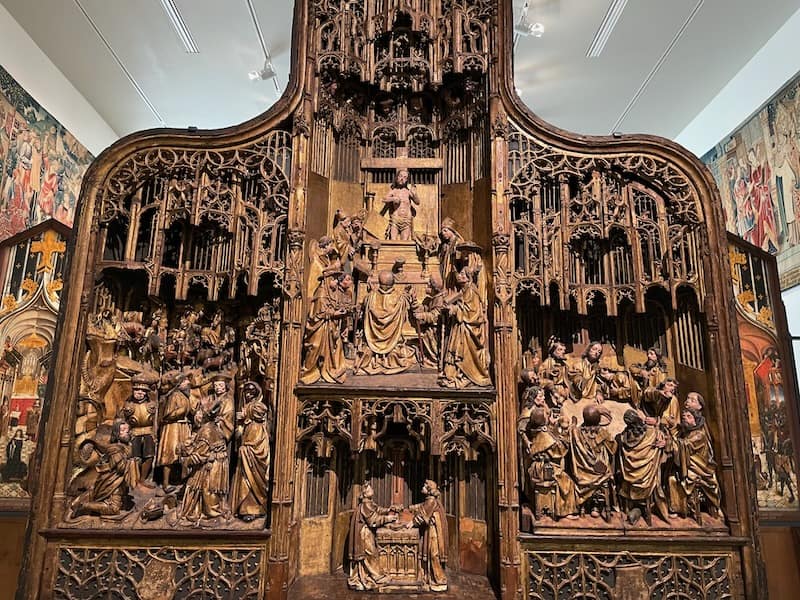 This wooden altar dates from the early 16th century and was sculpted in Flanders, in Antwerp, showing a mass being celebrated. Left, lamb being sacrificed; right, benediction of Abraham. ©OffbeatFrance/Leyla Alyanak
This wooden altar dates from the early 16th century and was sculpted in Flanders, in Antwerp, showing a mass being celebrated. Left, lamb being sacrificed; right, benediction of Abraham. ©OffbeatFrance/Leyla Alyanak7. Bookbinding plates
The museum has several book covers designed for use of exceptional publications, such as illuminated manuscripts. I simply found these magnificent and wanted to share them with you.
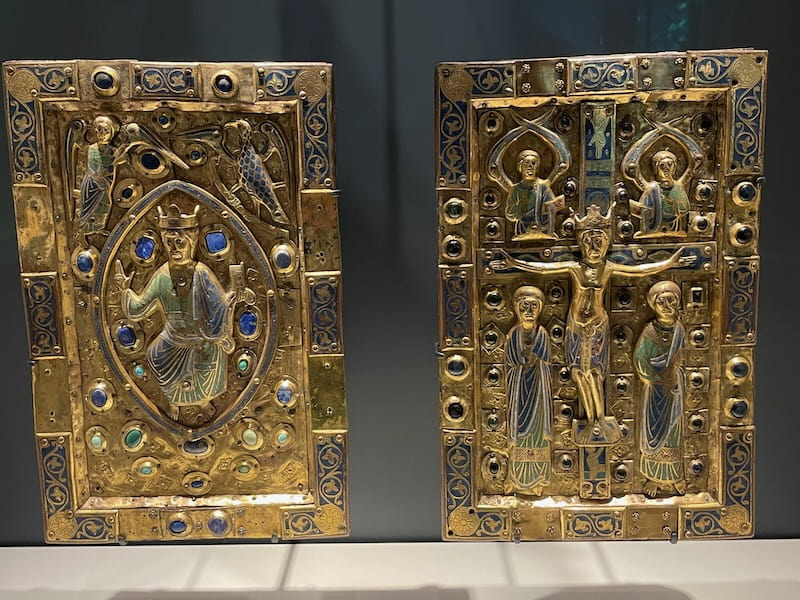
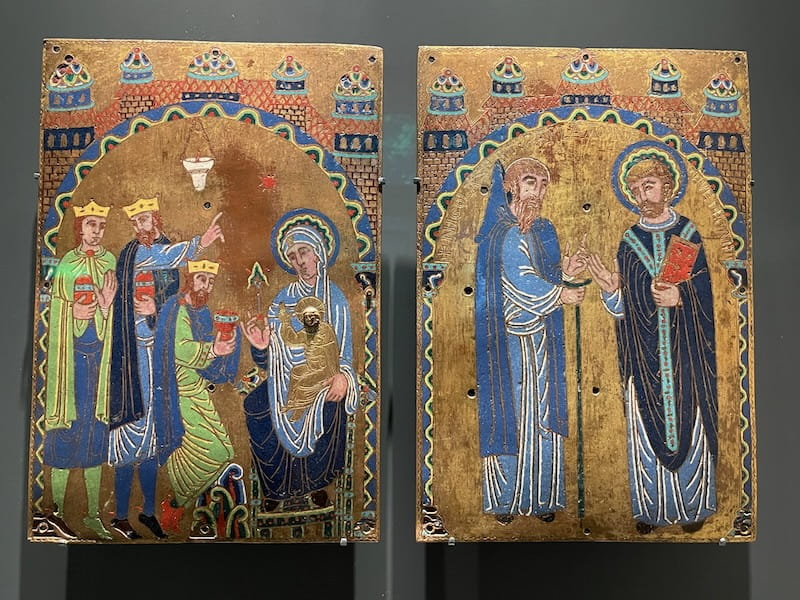
8. Directory of goldsmiths
This is an unusual item and I have yet to ascertain exactly how it was used, but it’s a directory of goldsmiths from the city of Rouen, showing each individual punch or stamp, perhaps to help in authenticating valuable works.
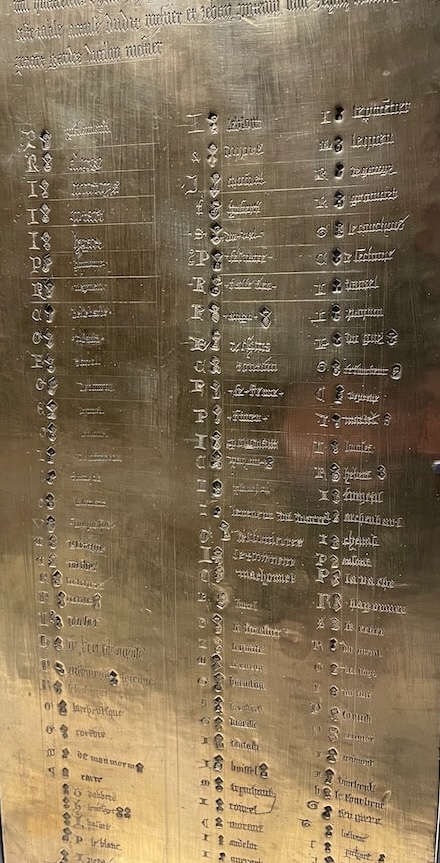
9. The chapel
The chapel is a delightful room and you’ll miss the best part if you don’t look up.
There was once direct access to the garden from here, but today, what compels us is the structure’s architecture, which revolves around a single pillar resting in the center, from which spread four ribbed vaults. Small but intricate.
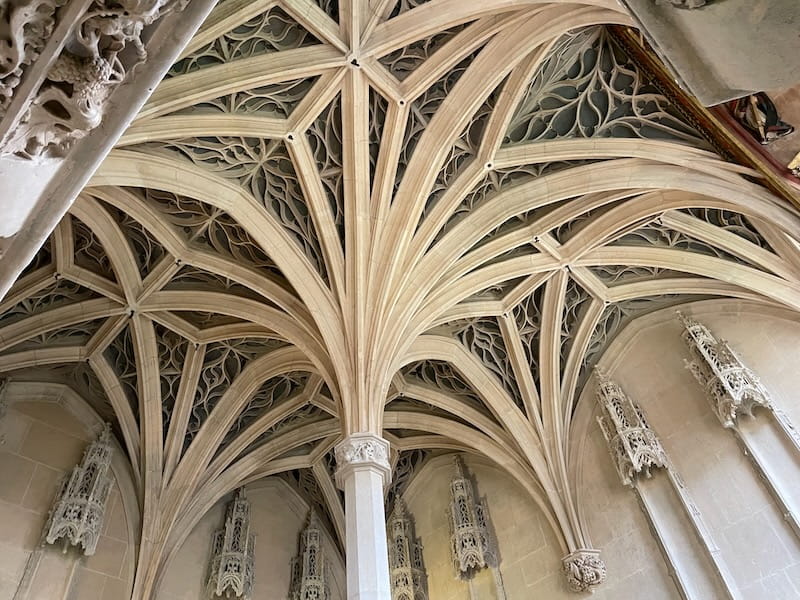
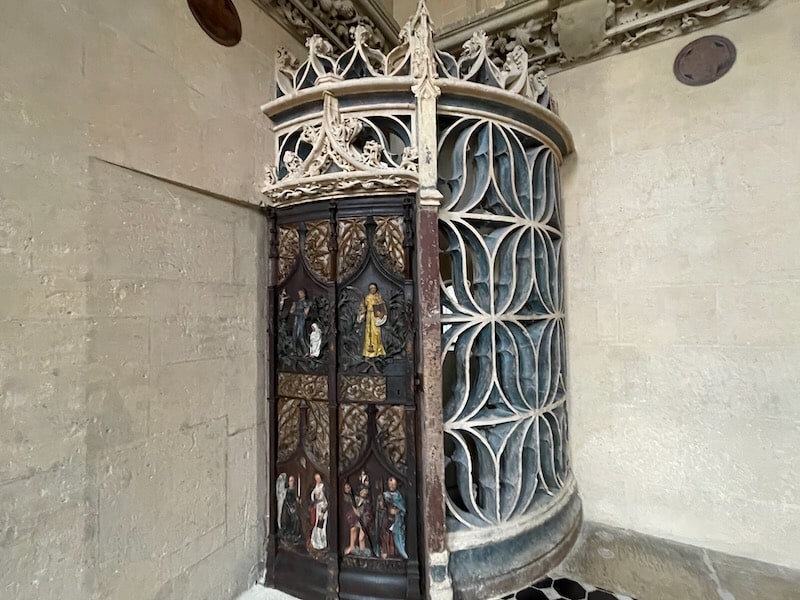 In addition to the ceiling, a small priory with polychrome painted panels remains in the room ©OffbeatFrance/Leyla Alyanak
In addition to the ceiling, a small priory with polychrome painted panels remains in the room ©OffbeatFrance/Leyla AlyanakThe chapel was regularly used by the owners of the building, the Abbots of Cluny, who used it as their Parisian residence. Today, it is the city's oldest standing "hotel particulier", or medieval Paris townhouse.
10. The chess players
This tiny gem (far smaller than it looks on a photograph) is made of bright yellow stained glass, and the competition of the game might well mirror a different kind of competition, perhaps involving a bit of romance. Just look at the facial expressions! Not to mention the way her hand is gently placed on his arm, or the angle at which he is leaning forward...
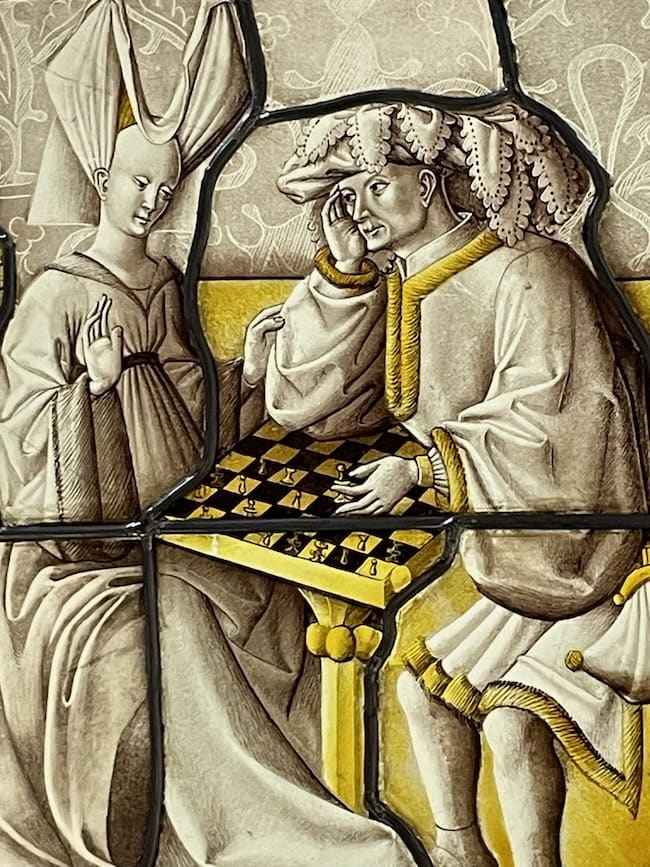
11. Lady and the Unicorn tapestries
And now, here we are, at last.
Six legendary tapestries from the late 15th century, probably woven in Flanders, whose skilled weavers were highly sought after.
Each tapestry is a standalone, and tells its own story about a unicorn and a lady. All follow a similar visual theme, with similar colors, and backgrounds filled with animals and flowers in the “millefleurs” style.
And yet, no one really knows what they mean.
They may represent the five senses, with the sixth dedicated to something a little less concrete, like soul or heart or love. Others see in them some sort of search for spiritual enlightenment. You can read what you want into them...
The Lady and the Unicorn, in detail
The tapestries are thought to date back to the end of the 15th century, commissioned by a rich family from Lyon, the Le Vistes, whose coat of arms you'll see scattered throughout the tapestry series. An artist would have been hired to draw them, with the drawings then sent to Flanders for weaving.
We only know this because after being lost to history for some four centuries, they resurfaced suddenly.
The first time they were brought to anyone’s attention was in 1841, when gender-fluid writer George Sand saw them at the Chateau de Boussac, where she was staying. She promptly told her then lover, Prosper Mérimée, about them, and he had them listed in the directory of historic monuments he was in charge of compiling.
Sand (who also had a decade-long liaison with pianist Frederic Chopin) wrote of eight tapestries, not six, and historians have been trying to determine the fate of the other two. It is believed the owners of the chateau where they were discovered, dirty and rat-infested, may have used the other two as wagon covers or as rugs, but no trace has ever been found.
The Cluny Museum bought the six existing tapestries in 1882, cleaned them up, and the rest is history, providing magic and fascination to everyone who visits.
➽ Lighting in the room dedicated to the Lady and Unicorn series is designed for observation, not photography. I took these with an iPhone but you can find clearer images on the Cluny Museum website, if you'd like to examine them more closely.
Sight
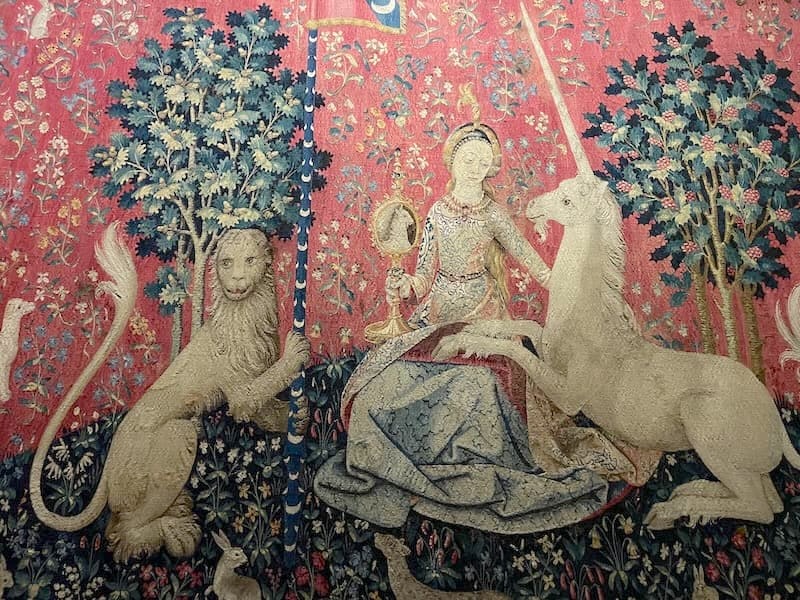
Here, we see a lady holding a mirror so that the unicorn can see its own reflection. The mirror could symbolize vanity, while the unicorn’s reflection its innocence. Remember that back then, unicorns were believed to exist and their horns thought to have the ability to cure. They were fleet, so fast they could never be caught – except by a virgin. And they symbolized purity and virtue.
The lush garden, for its part, could be referring to fertility and the beauty of nature, given its many plants and flowers. These, by the way, are reproduced throughout the tapestries.
The fact that the lady's hair is loose rather than pinned up signals she is probably unmarried, hence the widely accepted virginal theme of this tapestry.
Hearing
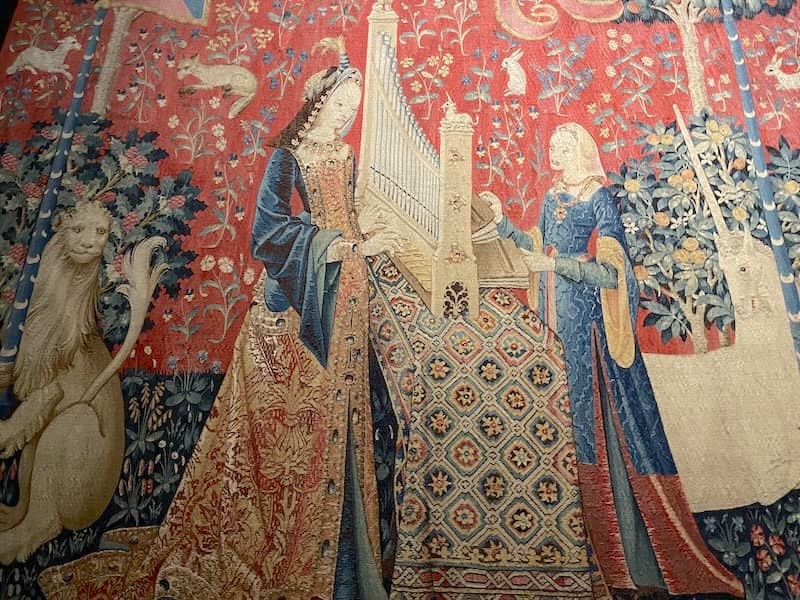
The message of sound is clear, with the lady playing an instrument and the unicorn listening with rapt attention. The musical instrument could be a symbol of harmony, and even the unicorn seems pleased.
Smell
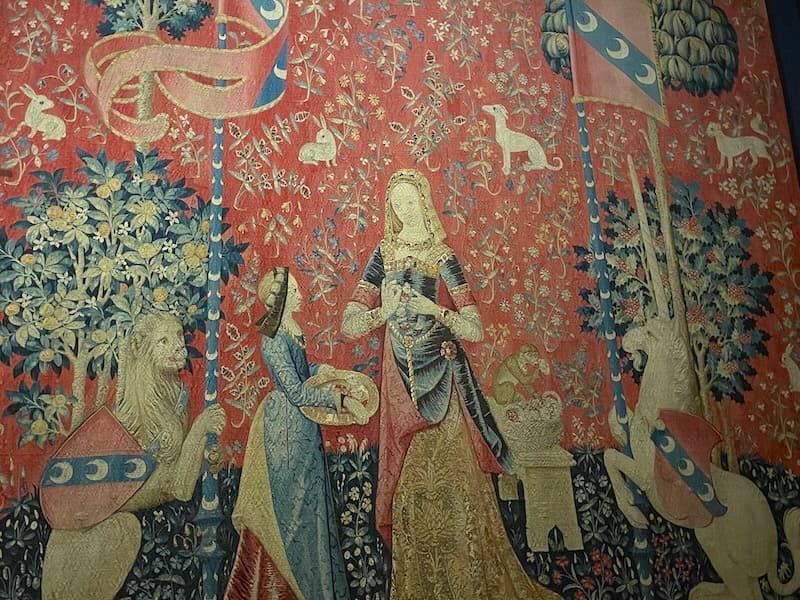
The lady is holding a small bouquet of flowers, while the unicorn is breathing in the aroma of a bush.
The floral bouquet could symbolize sensuality, and the unicorn’s enjoyment of it the call of earthly pleasures. The coat of arms of the Le Viste family is becoming ever more visible.
Taste
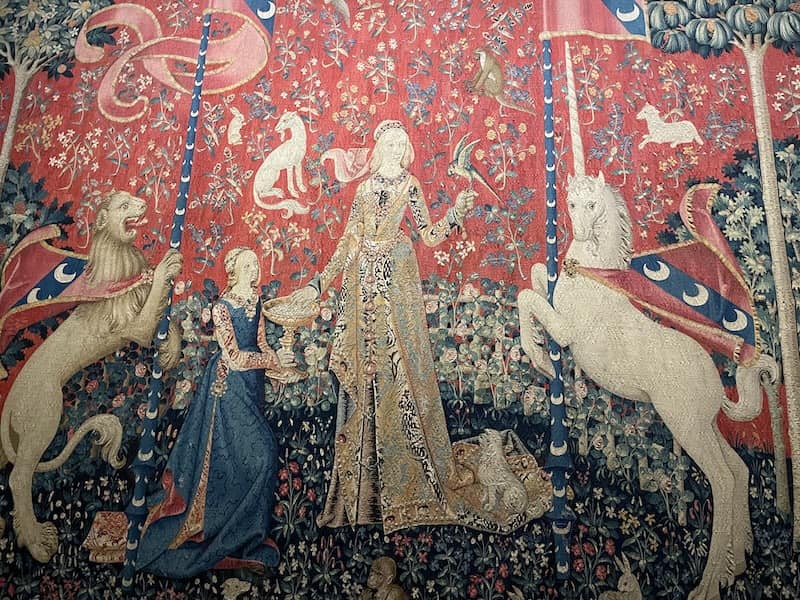
There is sweetness and indulgence in this tapestry, with the lady reaching for a candy or sugar. Or perhaps she plans on sharing the sweet with the unicorn, who seems pleased, expectant, even. This may be an image of shared pleasures, of some kind of mutual involvement or satisfaction.
Touch
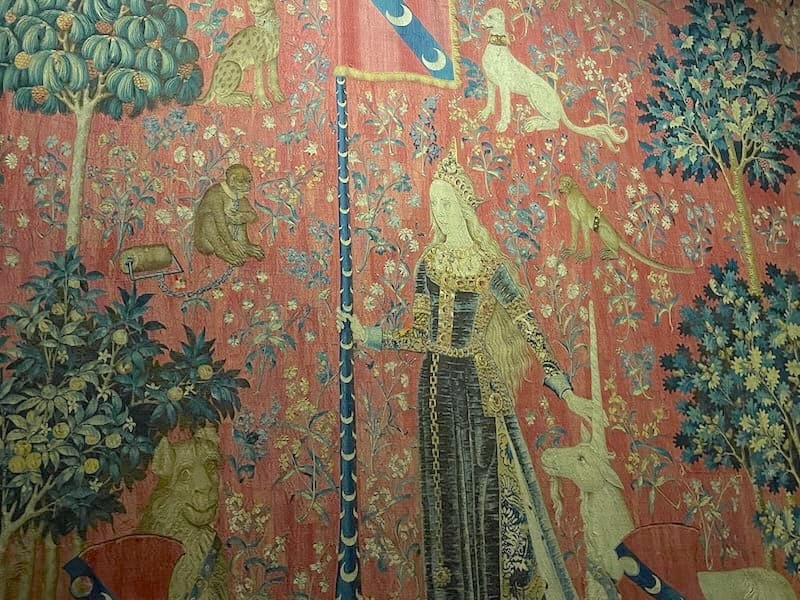
The lady holds the unicorn’s horn with one hand and her husband's coat of arms in the other. Some say this could symbolize wealth and materialism, but the touching of the unicorn could also represent intimacy, or healing (remember the horn's supposed healing properties?)
À mon seul désir (To my only desire)
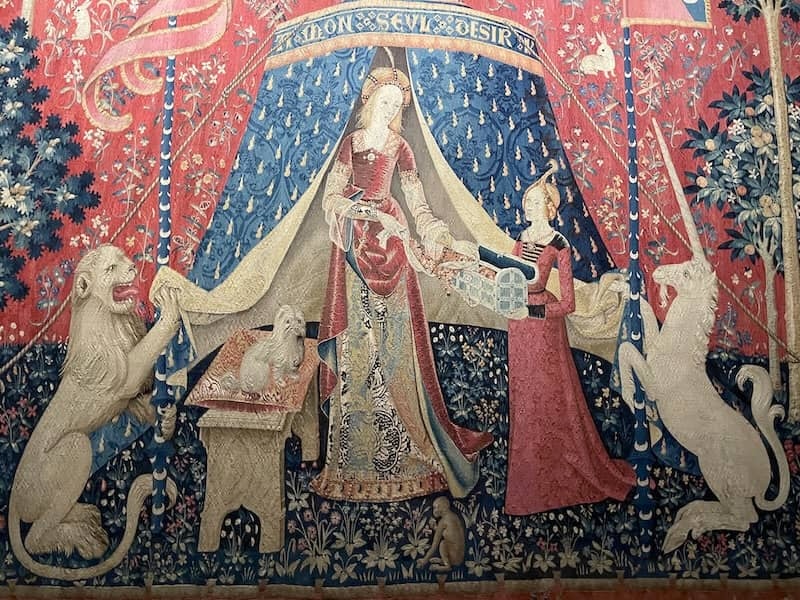
And herein lies the greatest mystery, the lady standing below those words – which no one has been able to understand.
She places her necklace into the casket, which could signify the handing back of earthly possessions, perhaps a rejection of sorts. The tent-like structure could represent an upcoming journey, with the lady’s gaze inviting us to enter the tapestry’s meaning, but without giving us many clues.
I’m sure you’ve made the connection by now but this final tapestry was also featured in Harry Potter and the Philosopher’s Stone, as the wall decoration in the common rooms of Gryffindor House, where it symbolized courtliness, valor and chivalry, qualities much respected during the medieval period.
And so the tapestries of the Lady and the Unicorn have enchanted us, surprised us, but not enlightened us. No documentation about their meaning exists, and we can only guess as we sit in the darkened room, trying to capture the message she is trying to send us.
The medieval mansion that became a museum
As I mentioned, a religious order owned the property until the 19th century, when it was broken up into several lots. One of these was taken up by Alexandre du Sommerard, a senior auditor with the government, who happened to be fascinated by the Middle Ages.
When he died in 1842, the French government acquired the property along with his art collection, and so the museum opened its doors in March 1844.
A few years ago, extensive renovations were decided and it closed for 20 months, reopening in 2022 with a new entrance, reception area and gift shop, all designed by architect Bernard Desmoulin – no mean feat since he had to contend with the existence of giant Gallo-Roman baths...
Before you go…
The sheer beauty and exquisite craftsmanship of these pieces are enough to rivet visitors.
But they also serve a historical purpose, a bit like the famous tapestry of Bayeux, to tell the story of medieval times, to explain the luxuries of medieval noble lifestyles, or even to raise the perennial fascination with the mythical unicorn, one of many symbols contained in the tapestries.
The tapestries are among the greatest treasures of medieval art in existence, for their beauty, of course, but also for the intrigue and mystery which envelops them. It shouldn’t surprise us that they’ve been collectively nicknamed the “Mona Lisa of the Middle Ages”.
THE PERFECT BOOK TO READ BEFORE VISITING THE TAPESTRIES
An intriguing novel, The Lady and the Unicorn, by Tracy Chevalier, imagines the commissioning of the tapestries, their weaving in Flanders, and the meanings behind them. While a novel, much research went into the book, which brings the entire weaving process to life and opens a window into the courtly customs of the time. Buy it here on Amazon.
The Cluny, France's National Museum of the Middle Ages, is one of my favorite Paris museums, up there with the Carnavalet (about the history of Paris), and worth visiting several times, so next time you’re in Paris, don’t miss this little gem.
Did you enjoy this article? I'd love if you shared it!
